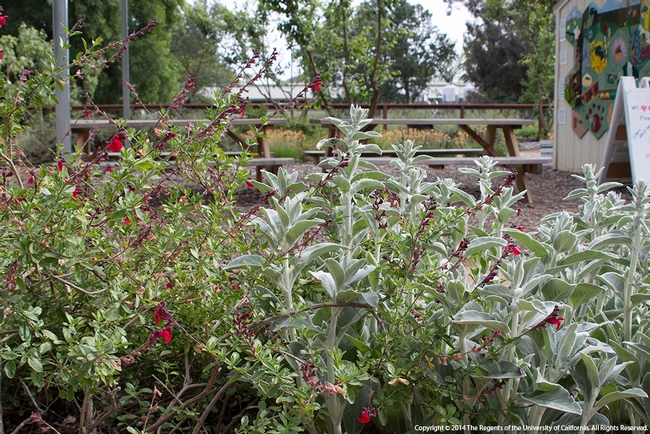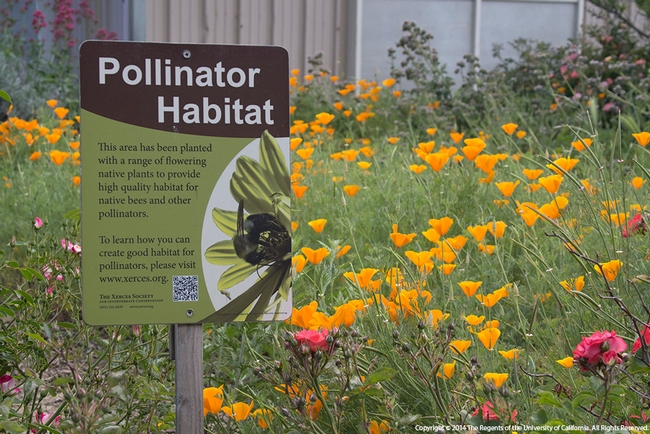
“Fall, with its cooler temperatures, shorter days, and imminent rainfall, is the best time to plant a bee garden in California. Much of the plants' growth at this time will be in the roots rather than the vegetative growth, and that gives new plants an advantage when temperatures warm up and the soil dries in the spring. Fall and winter are usually the wet seasons in California, and a bee garden will benefit from the natural pattern of rainfall that helps plants get established,” according to California Bee-Friendly Garden Recipes (Pawelek et al. 2015)
With fall being the perfect time for planting consider making your home landscape bee-friendly and follow UC Agriculture and Natural Resources' California Bee-Friendly Garden Recipes - 12 rules of thumb for creating a bee-friendly home landscape:
- Learn the seasonality of plants and bees.
Bees need both pollen and nectar resources from plants all year long. Sugary nectar provides energy for adult bees, and protein-rich pollen is used to feed their young. Plant not only a variety of plants (to ensure both pollen and nectar resources) but also make sure that they bloom at different times throughout the year, with the most active times of bees in garden running from February to October. - Provide a diversity of floral hosts.
A large variety of plants in a garden attracts a more diverse bee population. UC ANR researchers recommend planning a minimum of 20 different plant types to provide plenty of nectar and pollen sources for bees. If space or resources don't allow, consider plants that provide both nectar and pollen resources such as seaside daisy (Erigeron glaucus), blanketflower (Gaillardia x grandiflora), thyme (Thymus vulgaris), and coneflower (Echinacea purpurea). - Give structure to the garden.
When planning your garden arrange plants so it is easy to observe the bees that are visiting your landscape. Place taller plants or shrubs in the back and smaller or shorter plants in the front. Or you can plant in the shape of an island to allow viewing from all sides. - Plant in the sun.
Typically bees prefer flowers in the sunshine over the shade. Monitor the amount and location of sun in your home landscape and plant sun-loving bee-attractive plants in the sunniest section of your yard. - Plant shrubs, perennials and annuals in patches.
Most bees will visit one type or a few types of flowers each time they forage, an abundance of the same flower variety allows for more efficient foraging for bees. The California Bee-Friendly Garden Recipes publication recommends a 3.5 ft x 3.5 ft flower patch of the same variety. - Don't forget to seed annuals.
Plant seeds for spring blooming annuals and bulbs in the fall and take advantage of the winter rains and provide beautiful flowers in the spring. Great options include sunflowers (Helianthus annuus), Mexican sunflower (Tithonia diversifolia), California poppy (Eschscholzia californica), and zinnia (Zinnia elegans). - Maintain flowers.
Prolong a plant's blooming season by dead-heading. As soon as flowers begin to fade, wither and brown, pinch or cut-off the flower stem below the flower or right above the first set of healthy leaves. This allows the plant to continue to invest in producing more blooms and not seeds. - Create a watering regimen.
Regular watering of plants during blooming season allows plants to produce more flowers for a longer period of time. If a plant is water stressed it won't produce new flowers and nectar and pollen production declines. Consider plants that thrive in California's dry Mediterranean climate, UC Berkeley's Urban Bee Lab offers a list of the best bee plants with a large selection of California native options. - Do not use pesticides!
Applying pesticides to your home landscape can kill beneficial insects and bugs visiting your garden, including bees. Consider using integrated pest management practices that are natural or organic methods like hand-picking, spraying with water or natural insecticides. Contact your local UCCE Master Gardener Program to learn more about integrated pest management. - Consider plant climate zones.
Consider right plant, right place when selecting plants for your home landscape. Most gardening books, websites, plant labels and seed packets refer to a plants hardiness zone, climate zone or growing zone. Become familiar with the climate or microclimate in your area, the USDA Plant Hardiness Map and the Sunset Zone Map are a great starting guide for determining what plants will thrive in your garden space. - Provide homes for nesting bees.
A bee-friendly garden provides cover and a safe place for bees to raise young. Most bee habitats are either in the ground or in pre-existing cavities. Provide a nesting home for bees in your garden by leaving a small section of your landscape unmulched for ground-nesting bees. Nesting blocks, drilled holes in untreated wood or “bee-condos” can be offered to bees that prefer a pre-existing cavity habitat. - Provide nesting materials, including a water source.
Bees build their nests with mud, plant leaves and resins. Bees require a water source to not only drink but also to make mud for nest building. Fill a shallow water dish or birdbath to your garden, add small rocks or a floating cork for bees to rest and to prevent drowning.
Learn more with UC ANR and the UC Master Gardener Program

Interested in learning more about how to grow a buzzing bee-friendly garden? The UC Master Gardener Program has University trained volunteers who are eager to help. Volunteers are available to answer questions about preparing your soil, plant selection, pest management, and more. With local programs based in more than 50 counties across California and thousands of workshops a year there is sure to be an event or class near you. Visit our website to find your local UC Master Gardener Program, mg.ucanr.edu.
Resources:
Pawelek, Jaime C., Frankie, Gordon W., Frey, Kate, Leon Guerrero, Sara, and Schindler, Mary. 2015. “California Bee Friendly Garden Recipes.” ANR Publication 8518, http://anrcatalog.ucanr.edu/pdf/8518.pdf
Ponder, Marissa, Frankie, Gordon W., Elkins, Rachel, Frey, Kate, Coville, Rollin, Schindler, Mary, Pawelek, Jaime, and Shaffer, Carolyn. 2013. “How to Attract and Maintain Pollinators in your Garden.” ANR Publication 8518, http://anrcatalog.ucanr.edu/pdf/8498.pdf
UC Berkeley Urban Bee Lab, www.helpabee.org
Pollinator partnership, www.pollinator.org